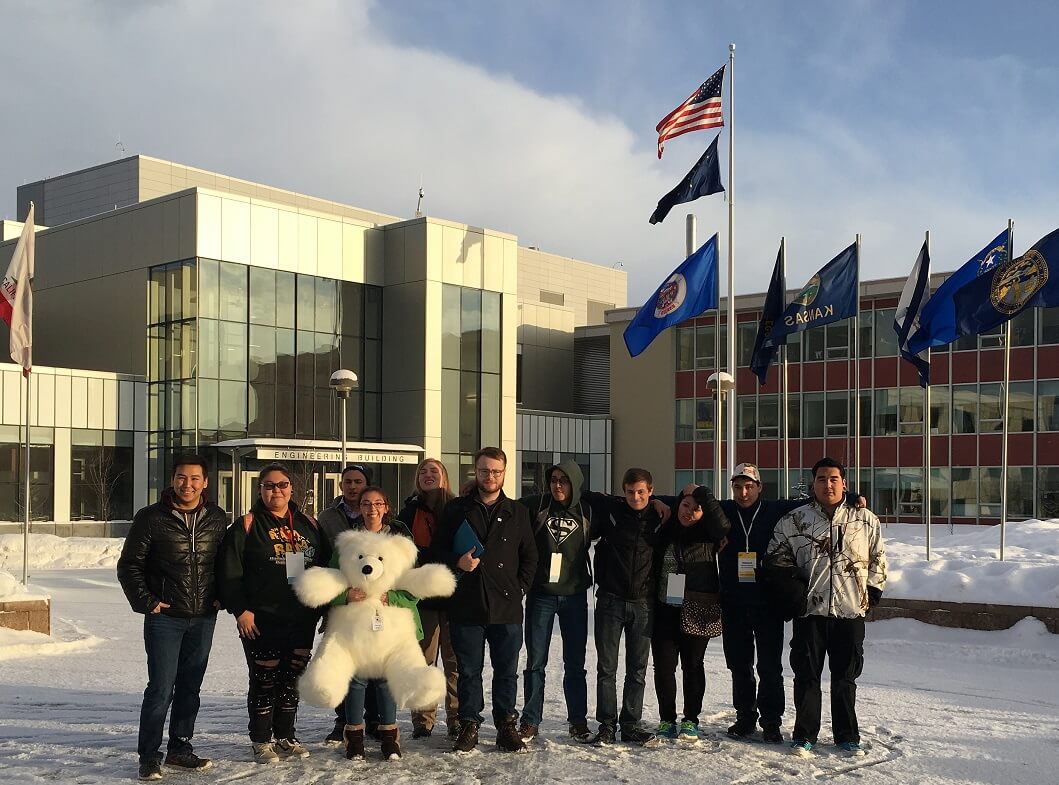 Last week the U.S. Arctic Youth Ambassadors converged in Fairbanks, Alaska for the Arctic Science Summit Week, an annual gathering of international scientists and policymakers who advance Arctic research. A number of other international Arctic events also took place in Fairbanks last week including the Arctic Observing Summit, the Model Arctic Council, and an Arctic Council Senior Officials Meeting. Throughout the week the young leaders had the opportunity to interact with hundreds of Arctic experts from around the world.
Last week the U.S. Arctic Youth Ambassadors converged in Fairbanks, Alaska for the Arctic Science Summit Week, an annual gathering of international scientists and policymakers who advance Arctic research. A number of other international Arctic events also took place in Fairbanks last week including the Arctic Observing Summit, the Model Arctic Council, and an Arctic Council Senior Officials Meeting. Throughout the week the young leaders had the opportunity to interact with hundreds of Arctic experts from around the world.
The Arctic Youth Ambassadors attended numerous sessions at the Arctic Science Summit Week on topics ranging from best practices for natural hazard protection in the Arctic, to the co-management of Pacific walruses, to strategies to reduce the incidence of suicide in indigenous groups. Some of the Ambassadors attended an Unmanned Aerial Vehicles (UAV) demonstration at UAF’s Alaska Center for Unmanned Aircraft Systems Integration (ACUASI) and participated in a discussion about the increasingly important role of UAVs in Alaska, including in fighting fires and cleaning up oil spills, with U.S. Senior Arctic Official Julia Gourley and ACUASI experts.
Arctic Youth Ambassadors Macy, Esau, Chelsea, and Jonas with Senator Lisa Murkowski
The Arctic Youth Ambassadors also had the opportunity to network with key decision-makers on Arctic issues such as Senator Lisa Murkowski, Lt. Governor Byron Mallott, Dr. Martin Jeffries, President Obama’s Assistant Director of Polar Science, and Admiral Robert Papp, US Special Representative for the Arctic. Some Ambassadors met with Arctic Council experts and representatives of the Inuit Circumpolar Council and the Saami Council, and learned about the important role of the Permanent Participants in the work of the Arctic Council. The Ambassadors were also invited to attend a dinner hosted by the U.S. Department of State where they met with Arctic experts and discussed Arctic health, energy, and policy.
A highlight for many of the Arctic Youth Ambassadors was meeting with participants of the Model Arctic Council, a group comprised of college students from Arctic nations who work together to draft solutions to Arctic challenges. The Arctic Youth Ambassadors were excited to meet other young leaders from across the circumpolar north who also care deeply about the Arctic. The two groups shared their stories and life experiences and discussed their visions for the future of the Arctic.
Arctic Youth Ambassador Reth Duir presents to the Model Arctic Council
In addition to meeting and getting to know indigenous leaders, policymakers, and other like-minded youth, the Arctic Youth Ambassadors also spent the week getting to know each other better. Arctic Youth Ambassador Alex Jorgensen said, “When I first became an Arctic Youth Ambassador, I cared about the Arctic, but I didn’t feel personally impacted by what’s happening in the Arctic. Now, I’m personally invested because my friends are being impacted, with homes being washed away and the weather affecting traditional ways of life. Because of this, I’m even more committed to getting more Alaska youth aware and involved so they care about Arctic issues, too.”
All in all, the Arctic Youth Ambassadors had an incredible week of learning, networking, and sharing. They raised awareness about their personal experiences living in a changing Arctic and they deepened their commitment to working together as Ambassadors to confront the challenges facing Arctic communities.
In the coming months, the Arctic Youth Ambassadors will be turning their attention towards their “Focus Projects” which are all centered around elevating the youth voice on Arctic issues. The topics range from community health and well-being, to climate change, to connecting youth to their Arctic environments. Stay posted – we’ll be hearing much more from these inspiring young leaders!
Meet all of the U.S. Arctic Youth Ambassadors at arcticyouthambassadors.org. Stay posted on the Arctic Youth Ambassadors social media sites: Facebook, Instagram, Twitter, and follow them on Snapchat! to learn more about what these extraordinary young Alaskans are doing to make a meaningful impact on the future of their communities.
Alaska Geographic is partnering with the U.S. Department of State and the U.S. Fish and Wildlife Service (which plays a key role in the Arctic Council’s Conservation of Arctic Flora & Fauna Working Group) to coordinate this program.

